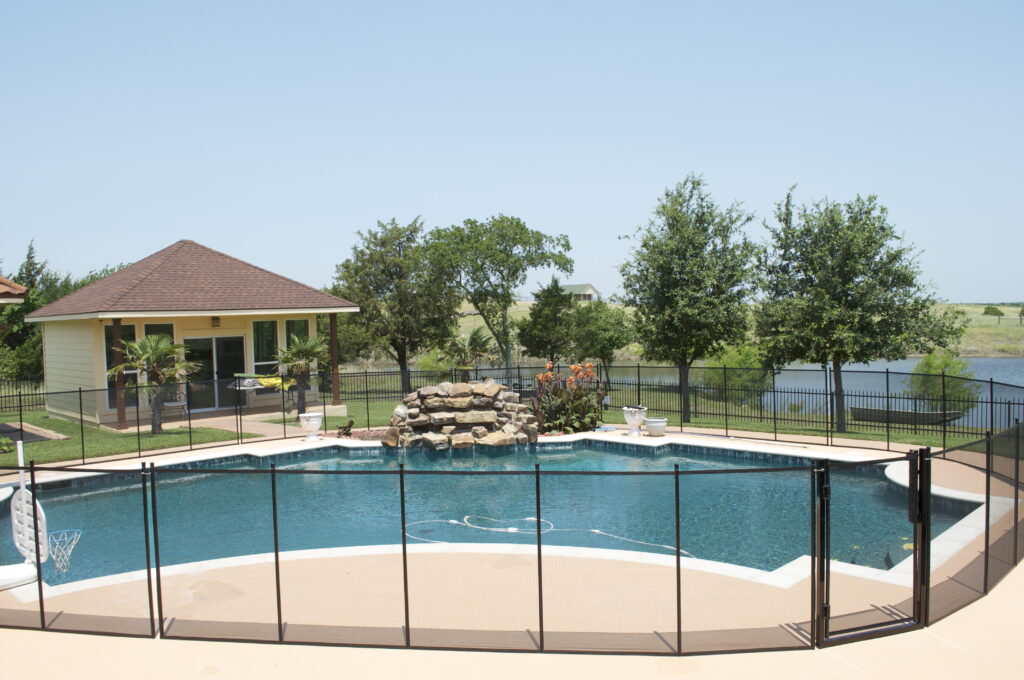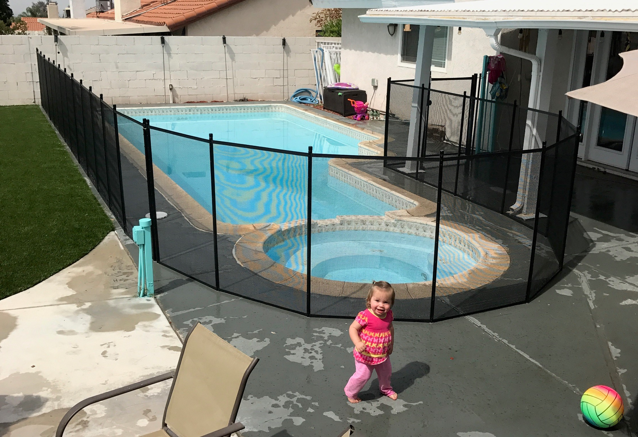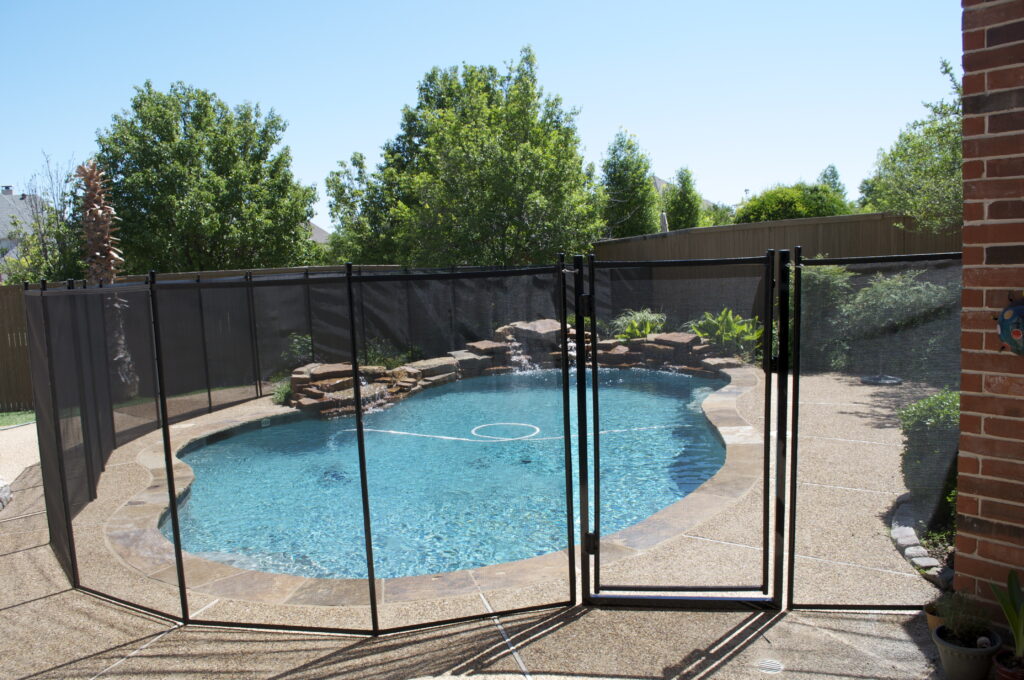If you’ve got a pool in Dallas and kids at home, you already know the mix of joy and worry that comes with it. On one hand, it’s where summer memories are made. On the other hand, there’s always that quiet concern of what if someone slips in when no one’s watching?
The truth is, pools can be safe and fun at the same time. It just takes a little planning, the right equipment, and a few smart rules.
The good news? Making your pool safer doesn’t have to be complicated. With the right setup, like a code-compliant pool fence for kids, pool and door alarms, as well as clearly outlined rules, you can enjoy your pool without the constant worry. Whether you’re just moving in or getting ready for another hot Dallas summer, we’ll walk you through the essentials of child pool safety in Dallas.

Keeping your pool kid-safe starts with covering the basics. This pool safety checklist includes the most effective steps Dallas families can take to protect children around water.
If you do one thing to protect your kids around the pool, start with a child proof pool fence. Dallas regulations require pool barriers that meet specific safety standards, including height, spacing, and gate features. A strong, professionally installed fence is the foundation of Dallas pool protection.
When it comes to materials, removable mesh fencing is a favorite among Dallas parents. It’s durable, see-through, designed specifically for child pool safety, and is the first choice for a pool fence for Dallas weather. You can take it down when needed, but when it’s up, it stands firm, creating a secure-climb-resistant barrier that blends into your backyard.
Aluminum fencing, while more permanent, isn’t always ideal for poolside use in North Texas due to potential corrosion and heat retention.
When shopping for a kids pool fence, make sure it:
Most importantly, your pool fence should comply with ASTM F2286 standards and follow the Consumer Product Safety Commission (CPSC) guidelines. Not every child safety pool fence does.
Fences are the first line of defense, but not the only one. A layered safety approach gives your family a better chance of avoiding accidents, even if someone makes a mistake or forgets to latch a gate.
Start with alarms. Door and gate alarms listed and labeled to UL 2017 notify you if someone enters the pool area. Surface wave detectors float on the water and trigger an alert if the water is disturbed. Combine these with pool safety covers that can support a child’s weight and prevent access when you’re not around.
For even more peace of mind, consider:
Each of these tools supports your fence, but in no way does it replace it. Together, they offer full-circle pool safety coverage in Dallas.
Technology helps, but there’s no substitute for supervision. According to the CDC, drowning is a leading cause of accidental death for children ages 1 to 4. In many cases, it happens when no one realizes a child slipped away.
Set clear pool rules that every family member understands:
Assign a designated water watcher during pool time. That means no phones, no multitasking, just keeping a close eye on the children at all times. Take turns with other adults and use a tag or wristband to make it official. And never, under any circumstances, leave the kids unattended to go inside the house. Two seconds is too long to turn your back on a child in water, as said by the Fort Worth Drowning Prevention Coalition.
Every second matters. Stay alert, stay present.

It might seem harmless to leave a float or pool toy in the water, but for young kids, their favorite water toy left near the pool’s edge can be just as tempting as the water itself. Bright colors and fun shapes are hard to resist, and many children have slipped into pools trying to grab a toy left behind.
Even if the gate is closed and the pool is covered, a child might try to reach or climb in to grab something floating on the surface. It doesn’t take long, and it doesn’t always make a sound.
One of the simplest ways to prevent accidents is to remove all floats, balls, noodles, and toys from the pool immediately after use. Out of sight often means out of mind, and that can make a big difference when it comes to child pool safety in Dallas.
By keeping the pool visually clear, you also make it easier to see the water and quickly notice if something’s wrong. It’s a small habit, but one that adds a valuable layer of protection, especially when paired with fences, alarms, and strong supervision.
One of the most overlooked parts of child pool safety in Dallas is swimming education. It’s never too early to teach your kids how to float, tread water, and understand basic pool rules.
Many Dallas-area swim schools offer toddler classes as young as 6 months. These lessons build confidence, reduce fear, and teach life-saving reflexes like rolling to float.
Even if your child can swim, reinforce these habits often:
When kids know what to do, they’re less likely to panic in emergencies.
And no matter their swim level, always keep child-sized life jackets nearby, especially during pool parties or when there are multiple kids around. A well-fitted life vest adds an extra layer of safety when distractions are high or when a child gets tired in the water.
Removable mesh pool fences are widely recommended for child safety. They’re tension-mounted, non-climbable, and include self-closing gates.
Yes. High-quality mesh fencing meets ASTM and CPSC safety standards. When professionally installed, it holds firm against pushing, pulling, and climbing attempts.
There’s no single answer; it’s about combining layers: a pool fence for kids, gate alarms, door locks, and pool covers. Add supervision and education, and you drastically reduce the risks. Together, they form a complete approach to child pool safety in Dallas.
Start with basic swimming lessons and clear, consistent rules. Programs in Dallas offer toddler swim classes that focus on floating, breath control, and comfort in the water. Reinforce these skills at home often.

You don’t have to sacrifice fun to protect your kids. When you build a safety-first pool environment, you create a space where your family can relax, play, and make summer memories with confidence.
From alarms and pool rules to swim lessons, life jackets, and yes, a code-compliant pool fence for kids, child pool safety in Dallas is all about layering protection. It’s not one thing. It’s everything working together.
Please fill out the form below with your information. Your local dealer will be notified about your inquiry.
Please fill out the form below with your information. Your local dealer will be notified about your inquiry.